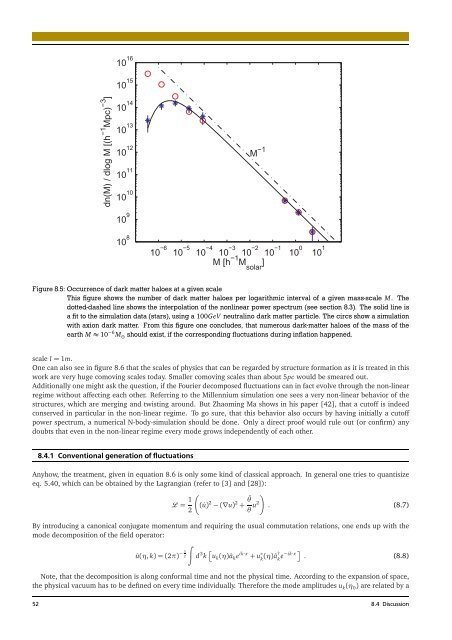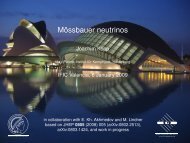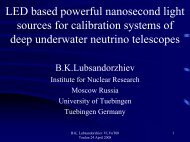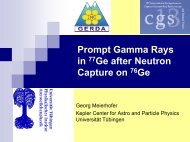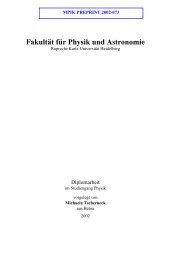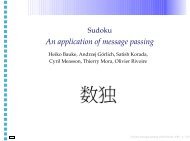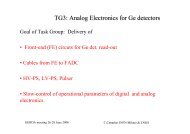Master Thesis
Master Thesis
Master Thesis
You also want an ePaper? Increase the reach of your titles
YUMPU automatically turns print PDFs into web optimized ePapers that Google loves.
dn(M) / dlog M [(h −1 Mpc) −3 ]<br />
10 16<br />
10 15<br />
10 14<br />
10 13<br />
10 12<br />
10 11<br />
10 10<br />
10 9<br />
10 8<br />
M −1<br />
10 −6 10 −5 10 −4 10 −3 10 −2 10 −1 10 0 10 1<br />
M [h −1 M ]<br />
solar<br />
Figure8.5: Occurrenceof darkmatter haloes at a given scale<br />
This figure shows the number of dark matter haloes per logarithmic interval of a given mass-scale M. The<br />
dotted-dashed line shows the interpolation of the nonlinear power spectrum (see section 8.3). The solid line is<br />
afit tothe simulation data(stars), usinga100GeV neutralino darkmatter particle. The circsshow a simulation<br />
with axion dark matter. From this figure one concludes, that numerous dark-matter haloes of the mass of the<br />
earth M≈ 10 −6 M ⊙ should exist,if the correspondingfluctuations duringinflation happened.<br />
scale l= 1m.<br />
One can also see in figure 8.6 that the scales of physics that can be regarded by structure formation as it is treated in this<br />
work are very huge comoving scales today. Smaller comoving scales than about 5pc would be smeared out.<br />
Additionally one might ask the question, if the Fourier decomposed fluctuations can in fact evolve through the non-linear<br />
regime without affecting each other. Referring to the Millennium simulation one sees a very non-linear behavior of the<br />
structures, which are merging and twisting around. But Zhaoming Ma shows in his paper [42], that a cutoff is indeed<br />
conserved in particular in the non-linear regime. To go sure, that this behavior also occurs by having initially a cutoff<br />
power spectrum, a numerical N-body-simulation should be done. Only a direct proof would rule out (or confirm) any<br />
doubts that even in the non-linear regime every mode grows independently of each other.<br />
8.4.1 Conventionalgenerationoffluctuations<br />
Anyhow, the treatment, given in equation 8.6 is only some kind of classical approach. In general one tries to quantisize<br />
eq. 5.40, which can be obtained by the Lagrangian (refer to [3] and [28]):<br />
�= 1<br />
�<br />
(˙u)<br />
2<br />
2 −(∇u) 2 ¨θ<br />
+<br />
θ u2<br />
�<br />
. (8.7)<br />
By introducing a canonical conjugate momentum and requiring the usual commutation relations, one ends up with the<br />
mode decomposition of the field operator:<br />
�<br />
3<br />
−<br />
û(η, k)=(2π) 2<br />
d 3 k � u k(η)â ke ik·x + u ∗<br />
k (η)â†<br />
k e−ik·x� . (8.8)<br />
Note, that the decomposition is along conformal time and not the physical time. According to the expansion of space,<br />
the physical vacuum has to be defined on every time individually. Therefore the mode amplitudes u k(η 0) are related by a<br />
52 8.4 Discussion


